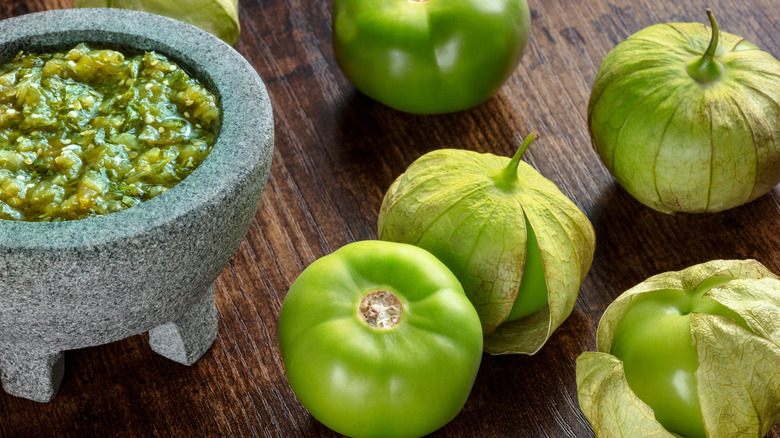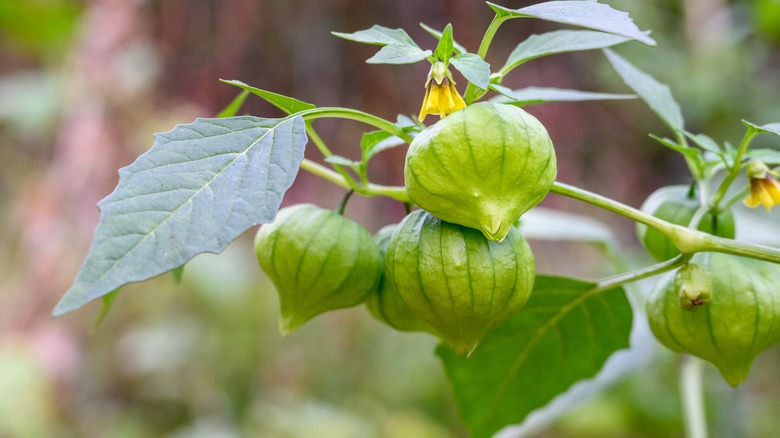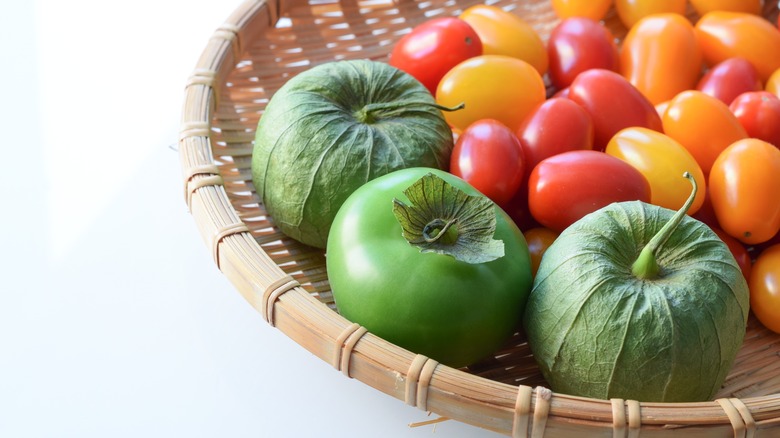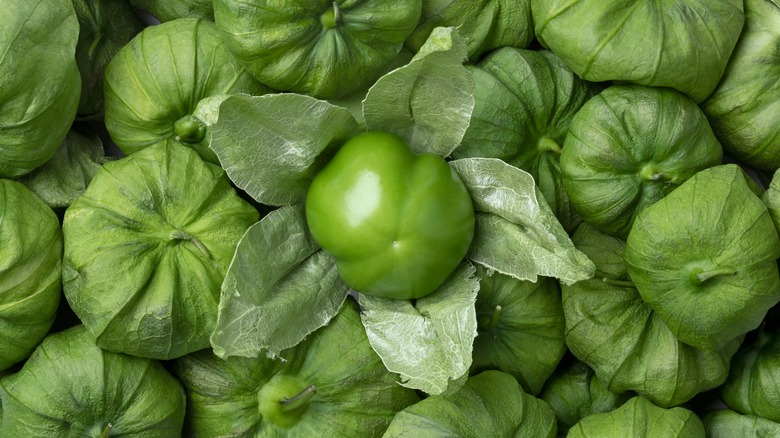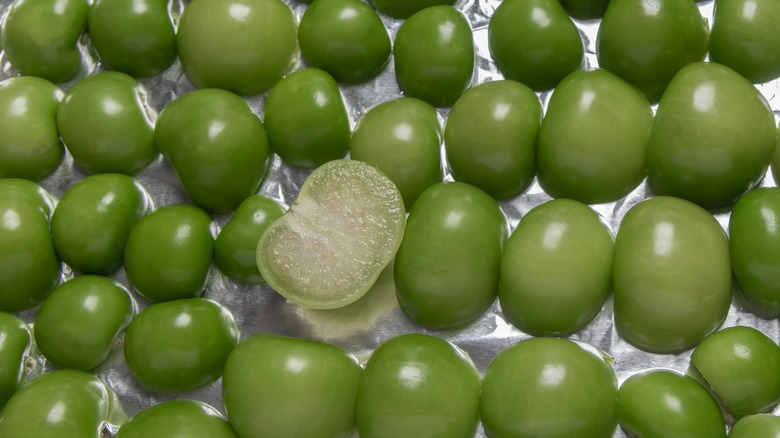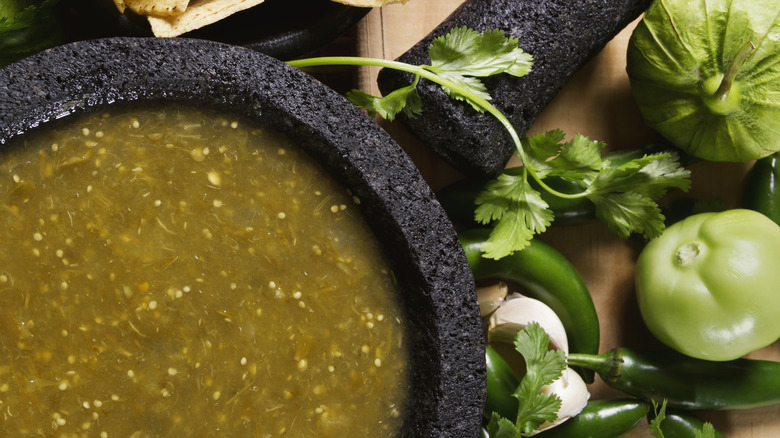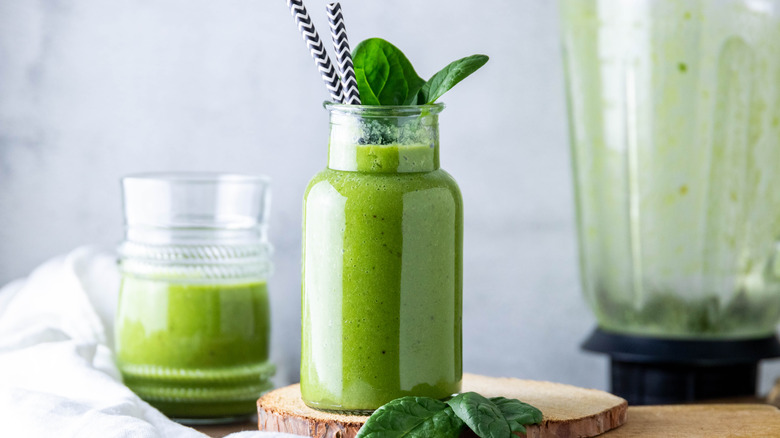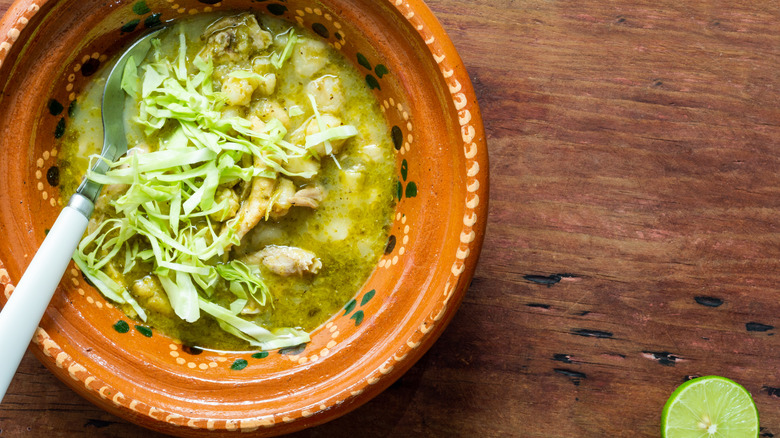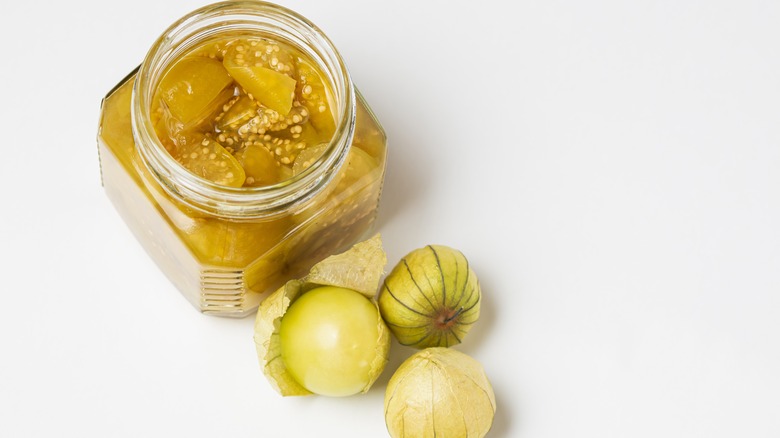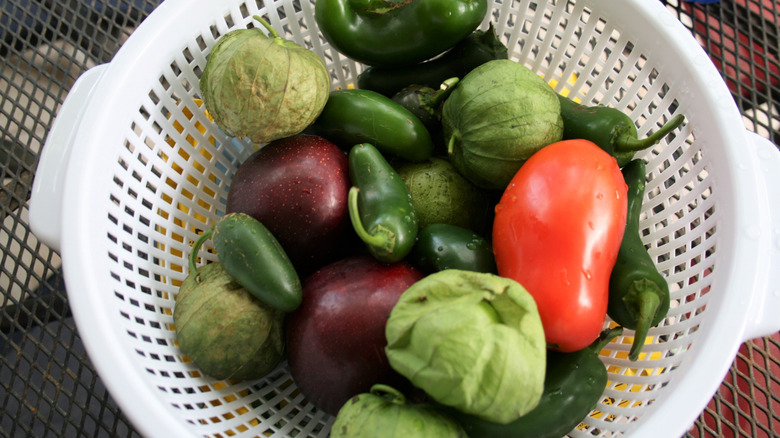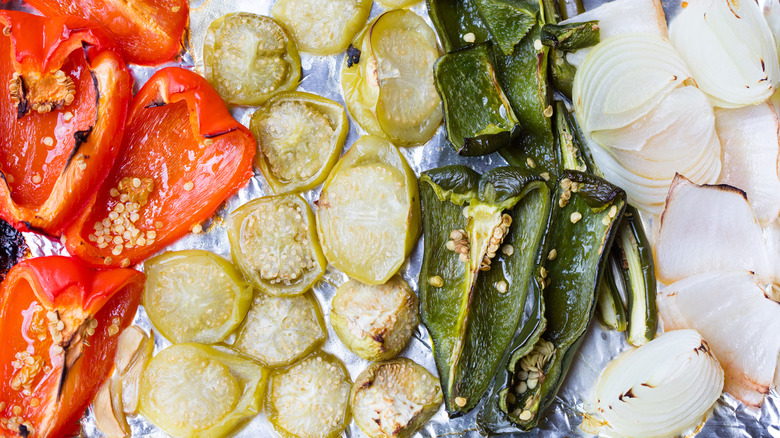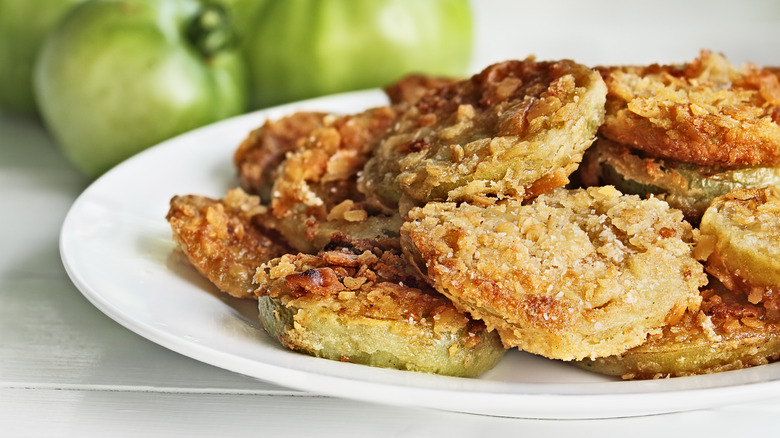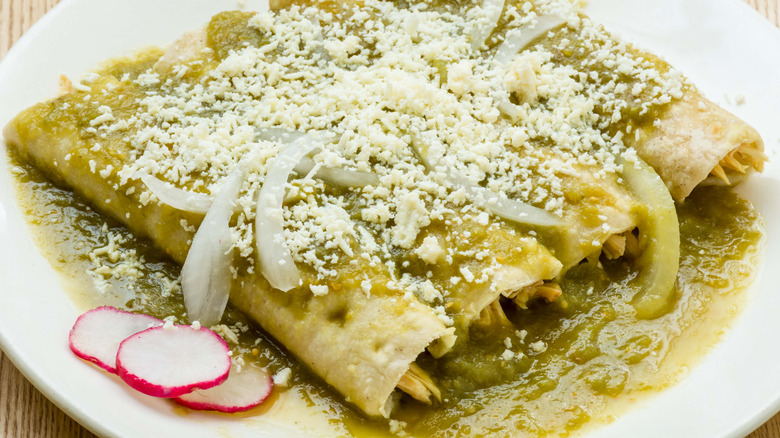What Are Tomatillos And What Can You Do With Them?
If you're a fan of Mexican and Central American cuisines, you're probably already quite familiar with the tomatillo. A staple ingredient in salsa verde, these unique husk-covered fruits are used in many Latin dishes. They also make appearances in Indian dishes. But other than that, tomatillos aren't too widely used across the globe. However, they are worth getting to know, as tomatillos are versatile ingredients that can be utilized in various recipes and cuisines.
In addition to adding vibrancy to dishes, tomatillos are also nutritious. They're low-calorie and low-fat fruits that provide plenty of important vitamins, minerals, and fiber, making them a great addition to just about any diet (via WebMD). If you're wondering how to incorporate tomatillos into your cooking, we've got you covered. From exactly what they are and what they taste like, to how to shop for and prepare them, and even a few recipes to get you started, keep this guide handy if you want to start bringing more tomatillos into your life.
Tomatillos are a kind of fruit
The tomatillo is a member of the nightshade family, along with other edible plants like potatoes, tomatoes, and peppers. While its name — which means "little tomato" in Spanish — makes it seem like it's a variety of tomato, it's actually a separate species. The tomatillo consists of a round berry fruit inside a papery husk. Most tomatillos you'll find are green, although there are yellow and purple varieties as well. Sizes vary, but generally, tomatillos are smaller than your average tomato, growing to about an inch or two in diameter.
Tomatillos have been a staple ingredient in Central American cuisine since ancient times, and the Aztecs were the first culture known to grow them. Unlike tomatoes, another Mesoamerican crop that eventually spread in popularity across the globe, tomatillos haven't caught on in the same way. However, you will find it in some Indian recipes, like chutneys and curries. Tomatillos are grown in India, as well as Mexico, Guatemala, the United States, South Africa, and Australia. The plant thrives in warmer growing regions.
The tomatillo fruit itself, underneath the husk, possesses firm flesh with small seeds. The flavor is tart and tangy with a sour juiciness, almost like lemon or lime juice. It's this acidic quality that makes tomatillos such a useful and versatile cooking ingredient.
They're different from tomatoes
Because of their name and appearance, tomatillos are often confused for tomatoes, particularly green tomatoes. But there are key differences between the two species of fruit which are important to understand when preparing, cooking, and eating either of them. They do have some similarities, too, and can in some instances be used more or less interchangeably, so it's good to know the main characteristics of each ingredient that set them apart.
Tomatillos have a sharper, more acidic flavor than your average tomato, as well as firmer, crisper flesh. These traits are particularly noticeable when the fruit is raw, which is why tomatillos are so often roasted, grilled, or at the very least blanched — cooked briefly in simmering water — before they're eaten or used in a recipe. Tomatoes, on the other hand, have softer flesh and a sweeter, gentler flavor, and so are often consumed in their raw state.
Tomato varieties vary much more widely when it comes to size, with things like grape tomatoes being of a very different size than hefty beefsteaks. Tomatillos, on the other hand, usually stay within the one to two-inch range. The same goes for color — green tomatillos are the most common, with a few other hues available — while tomatoes can be found in just about every shade of the rainbow. Tomatoes' greater variety may explain their greater popularity, but tomatillos' unique flavor and texture make them just as useful and delicious.
Shopping for and storing them is easy
When shopping for tomatillos, there are a few visual and tactile clues that can help you select the best ones. If you're planning to use them right away, you want to make sure the fruits you select are properly ripened, but not too old. Take a look at the papery husk: you want it to be green, and it should fit fairly tightly over the fruit underneath. A few tears in the husk are a good sign that the tomatillo is ripe, but the covering should still be more or less intact. It should also feel soft, not dried out or crumbly. The fruit underneath should be solid — without cracks or holes — and firm to the touch. There's usually a sticky, sap-like substance between the husk and the fruit; this is totally normal and not a sign of a bad tomatillo.
Once you get your tomatillos home, you can leave the husks on if you're not planning to cook them immediately. The fruits are kept best in a paper bag, either out at room temperature if you're using them in a day or two, or in the refrigerator if you want to store them for a few weeks. Tomatillos can be frozen, too. Simply take off the husk, wash and dry the tomatillo's exterior, and then freeze them puréed, chopped, or left whole. Use frozen tomatillos within a year for the best results.
You need to remove their husks
Tucked in their odd, cocoon-like husks, tomatillos may seem like a daunting ingredient to work with. But they really only take a small amount of know-how and prep work to use properly. There are two things a cook must deal with when preparing tomatillos: the husk and the sticky residue underneath.
Tomatillo husks are easy enough to take off. Simply peel them with your fingers until the entire papery piece is removed. Between the husk and the fruit's surface, however, it gets a little more tricky, as a substance that works as a natural insect repellent may be present. It's unpleasantly tacky and may stick to your fingers. There are two ways to get it off. You can rinse the tomatillos under cold running water as you scrub the substance off the fruit, or you can leave the tomatillos to soak in water for several minutes. Hands-on or hands-off, either method will remove the residue, leaving you with fresh, clean fruit.
They work great in raw or roasted salsa
One of the most common ways tomatillos are utilized in Mexican cuisine is to make salsa. Tangier and zipper than tomato-based salsa, tomatillo salsa — often called salsa verde due to its green hue — is a super versatile sauce that can be enjoyed in a multitude of ways, including as a condiment and or as a dip. Just like with tomato salsa, you can make salsa verde with raw or cooked tomatillos, depending on the flavor profile you're going for.
Raw tomatillo salsa packs quite an acidic punch, and the firm flesh of the tomatillos gives it a lively crunch. It couldn't be easier to make, either. Simply throw your tomatillos and other ingredients — like jalapeños, cilantro, garlic, and onion — together. Then, chop, mash, or whiz them in a blender to get the texture you want. Bump up the acidity with lime juice, or turn it down with some avocado, as with this salsa verde con aguacate.
If you prefer a deeper, earthier salsa, you can roast, grill, or broil the tomatillos, and other recipe ingredients, before mixing them together. Cooked tomatillos will lose some of their harsh bite, becoming a little bit sweeter and juicier. The recipe will still have some of that signature tomatillo zing, just with a little less intensity. This charred salsa verde is a good example of this style.
You can also use them in drinks
Tomatillos' vibrant color and flavor make it an excellent ingredient not just in food, but in beverages, too. You can utilize the fruit in drinks using two methods. You can blend or purée the tomatillos if you want to keep the drink thickly textured. On the other hand, you can juice and strain the fruits if you want a thinner texture. Either way, you'll have a dazzlingly bright ingredient that will add tons of zip and zing.
Including tomatillos in smoothies gives them that nice fresh bite, while also adding the vitamins and minerals present in the fruit to up the nutrition factor. Tomatillo juice, on its own, is also super refreshing to sip on. It's arguably at its best, though, when balanced with other ingredients in cocktails or mocktails. Use tomatillo instead of tomato to make a not-so-bloody version of the bloody Mary. If you're using tequila instead of vodka, a green bloody Maria. Try adding a splash of the tangy, vegetal juice to classic cocktails like the mojito or the margarita.
Tomatillos work great in soups and stews
Whether you're making a long-simmering pot of hearty stew, or whipping up a bowl of soup for a quick lunch, tomatillos are there for you. It's hard to imagine an ingredient better suited for soups and stews — no matter what style you're preparing. Used raw or lightly blanched, tomatillos can be puréed or juiced to add their distinctive acidic tang. Roasted, grilled, or simply stewed along with other ingredients, cooked tomatillos give soups and stews another layer of bright flavor.
While classic gazpacho is made with tomatoes, you can make a cool and refreshing green variation using tomatillos instead. The result will be lighter and brighter than your typical red gazpacho. Other fresh green ingredients like cucumber, celery, lime, green peppers, and bright herbs can all enhance the tomatillos' vibrancy.
To showcase the rich, comforting side of tomatillos, pozole verde is the way to go. This traditional Mexican stew typically includes long-cooked tender pieces of pork or chicken along with hominy, swimming in a base made from tomatillos, chiles, and stock, and served with a selection of garnishes.
They can be turned into pickles or preserves
If you find you have too many tomatillos that you don't know what to do with, and you don't want to freeze them, there are two other great ways to lengthen their shelf life: pickling and preserving. Both of these techniques also give tomatillos a new flavor and texture.
To pickle tomatillos, you can go one of two ways: a longer, fermented pickle, or a quick pickle (also known as a refrigerator pickle). Fermented pickles need salt, water, and time. It's important to follow a trusted recipe to ensure safe practices. The benefit of using the fermentation process is that it creates a more complex flavor. For refrigerator pickles, you create a simple brine of water, salt, and vinegar — along with any other flavor ingredients you want to add. This could include garlic, herbs, and whole spices. Finally, submerge the tomatillos and let the mixture sit in the refrigerator. The longer you let them sit, the more sour and tangy the tomatillos will get.
Tomatillos can also be preserved by making a tomatillo jam. Depending on what other ingredients you add, you can make the jam as savory, spicy, or sweet as you'd like. Tomatillos match up well with all of those different flavor profiles.
You can sometimes use them as a tomato substitute
If you're looking for a way to add a little more zing to salads and sandwiches, take any favorite recipe that includes tomatoes and replace them with tomatillos. The additional pop of acidity will add a new brightness to old flavors. Plus, the firm texture of tomatillos — particularly when raw — holds up extremely well in sandwiches and salads. These fruits won't become mushy or soggy as quickly as a tomato.
Slices of tomatillo make a great addition to the classic BLT sandwich, as their fresh acidity contrasts nicely with the savory richness of fried bacon. If sliced, raw tomatillos have too much bite for your palate, heating them for a minute in a pan will tone down their harshness. That makes them perfect when layered in a grilled cheese. The cooking process brings out their sweet and fruity quality, while the tartness cuts through the opulence of melted cheese and buttery bread.
In salads, chopped tomatillos enhance the vibrancy of other acidic ingredients, matching well with citrus and vinegar dressings. Their firm flesh brings a satisfying crunch to salads with softer textured ingredients. If you're roasting tomatillos before adding them to a salad, don't overcook them.
Roasted tomatillos make a delicious side dish
One of the simplest and most satisfying ways to prepare tomatillos is to simply roast them in the oven. Rather than turning them into salsa, serve them how you would serve any roasted vegetable dish. The best thing about this technique is its ease: once the fruits are prepped, you place them on a sheet pan, throw them in the oven, and relax until they're done.
Slicing the tomatillos in half before you place them on the pan keeps them stable as they roast. It also exposes their interior flesh to the hot surface for a nice browning effect. A coating of olive or other oil and a sprinkling of salt is all you need. But feel free to add spices to bring out more flavor. Cumin, oregano, and chili powder are all good choices. You can roast tomatillos on their own, or alongside garlic, onion, peppers, or any other vegetables you like.
A long, slow oven roast will bring out tomatillos' natural juicy sweetness. If you prefer a smoky char, you can throw the pan under a broiler for a few minutes to get a blackened exterior. Roasted tomatillos are an excellent side to serve with main dishes like roast chicken, as well as Mexican classics like carnitas or carne asada.
Try breading and air-frying them
The classic Southern dish of fried green tomatoes uses under-ripe slices of the fruit, since compared to ripe tomatoes they're firmer and have a tangier flavor. So why not use tomatillos instead? They offer a very similar texture and taste to under-ripe tomatoes, but pack a more acidic punch. These qualities make them ideal candidates for frying, as they hold their shape while adding a fresh, zingy flavor that helps cut through the richness of the dish.
Traditional fried green tomatoes are breaded in a cornmeal mixture, then shallow fried in a skillet of oil. You can follow any fried green tomato recipe, then simply use sliced tomatillos instead. On the other hand, you can experiment with different types of breading and frying techniques. Traditional breadcrumbs, panko breadcrumbs, cracker crumbs, or cornflake breading all add their own style of crunch. You can try deep fry for a richer fried flavor, or use an air fryer for a lighter version.
Top everything with tomatillo sauce
One of the most well-known tomatillo-based dishes is enchiladas Suizas. What makes this dish especially delicious — alongside cheese and chicken — is its sauce, which is made from a base of puréed tomatillos. The fruit's tangy, slightly sweet flavor is perfect for sauce, adding a bright zip of acidity to anything you serve it with.
Tomatillo sauce can be as tangy, sweet, or as spicy as you want to make it, depending on the other ingredients you use. Roasted peppers, onion, and garlic puréed with cooked tomatillos will give you a thick, flavorful sauce. This can be thinned out using stock, or other liquids, and then simmered until it's reduced to the consistency of your liking. Herbs, spices, citrus, and other seasonings can then be added to taste. Obviously great with enchiladas, this sauce can be served on just about anything, from grilled meats and vegetables to fried eggs to mashed potatoes. You can even add cream, or another type of dairy, to make it into a rich and opulent sauce — the natural tang of tomatillos keeps it balanced.
